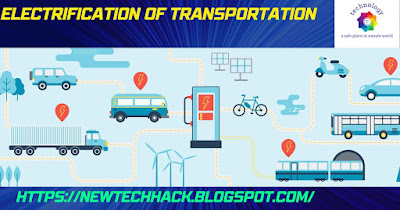The electrification of transportation
is a transformative shift in the way we power vehicles, with the aim of reducing reliance on fossil fuels and mitigating the environmental impact of transportation. By transitioning from internal combustion engines to electric vehicles (EVs) and incorporating electric charging infrastructure, we can significantly reduce greenhouse gas emissions and move towards a more sustainable future. In this article, we will explore the concept of electrification of transportation, discuss its importance, and examine its role in creating a cleaner and more efficient transportation system.
Understanding Electrification of Transportation:
Electrification of transportation involves replacing conventional vehicles powered by internal combustion engines (ICEs) with electric vehicles that run on electricity stored in batteries or fuel cells. Key elements of electrification include:
1. Electric Vehicles (EVs): Electric vehicles are automobiles that are powered by electric motors and utilize electricity stored in rechargeable batteries or generated by fuel cells. EVs can be fully electric (Battery Electric Vehicles, or BEVs), where they solely rely on batteries, or hybrid vehicles (Plug-in Hybrid Electric Vehicles, or PHEVs), which combine an electric motor with an internal combustion engine.
2. Charging Infrastructure: To support the adoption of EVs, a robust charging infrastructure is essential. Charging stations are installed in public spaces, workplaces, and residential areas to enable convenient charging for EV owners. These charging stations can range from standard AC chargers to fast DC chargers, allowing for varying charging speeds.
Importance of Electrification of Transportation:
- Reduction of Greenhouse Gas Emissions: Transportation is a significant contributor to greenhouse gas emissions. Electrification reduces emissions by shifting from fossil fuel-powered vehicles to electric vehicles, which have lower or no tailpipe emissions. When powered by renewable energy sources, EVs can virtually eliminate direct emissions, contributing to climate change mitigation.
- Improved Air Quality: Electric vehicles produce zero tailpipe emissions, reducing air pollution and improving air quality in urban areas. This has positive implications for public health, as it reduces the emissions of harmful pollutants like nitrogen oxides (NOx) and particulate matter (PM).
- Energy Efficiency: Electric motors are more efficient than internal combustion engines, converting a higher percentage of the energy from the grid to power the vehicle. This results in improved energy efficiency and reduces overall energy consumption in the transportation sector.
- Renewable Energy Integration: Electrification of transportation creates opportunities for the integration of renewable energy sources into the grid. EVs can be charged using electricity generated from renewable sources such as solar or wind, making transportation a part of the broader renewable energy transition.
- Energy Independence and Diversification: Electrification reduces dependence on fossil fuel imports and promotes energy independence. By diversifying the energy sources for transportation, we become less vulnerable to fluctuations in oil prices and geopolitical tensions associated with oil dependency.
- Technological Advancements: Electrification drives innovation in battery technology, charging infrastructure, and vehicle-to-grid integration. These advancements have the potential to improve energy storage, grid stability, and overall energy management.
Accelerating Electrification of Transportation:
- Incentives and Policies: Governments can implement policies and provide incentives to promote the adoption of electric vehicles, such as tax credits, rebates, and subsidies. Additionally, regulations can be put in place to encourage the development of charging infrastructure.
- Charging Infrastructure Expansion: Expanding the availability of charging stations is crucial to support the widespread adoption of EVs. Investments in public and private charging infrastructure, including fast-charging networks along major highways, urban areas, and workplaces, are necessary to alleviate range anxiety and enhance convenience for EV owners.
- Research and Development: Continued investment in research and development is essential to advance battery technology, charging infrastructure, and electric vehicle components. This includes improving battery range, charging speeds, and the durability and affordability of EVs.
- Collaboration and Partnerships: Collaboration between governments, automakers, utilities, and technology companies is vital to address challenges and foster the development of an integrated and sustainable electrification ecosystem. Partnerships can facilitate the sharing of knowledge, resources, and best practices.
- Consumer Awareness and Education: Raising awareness and educating consumers about the benefits of electric vehicles, including cost savings, environmental impact, and driving experience, can drive greater adoption. Information campaigns, test drives, and educational programs can help dispel myths and misconceptions about EVs.
The Future of Electrification:
The electrification of transportation is an essential pillar in the transition to a sustainable energy future. As technology advances, EVs are becoming more affordable, have longer ranges, and charging infrastructure is expanding. With the integration of renewable energy sources and the adoption of smart charging solutions, EVs will become an integral part of a decarbonized energy system.
In conclusion, the electrification of transportation presents a significant opportunity to reduce greenhouse gas emissions, improve air quality, and promote energy efficiency. Through the widespread adoption of electric vehicles and the development of robust charging infrastructure, we can create a cleaner and more sustainable transportation system. The electrification of transportation, combined with renewable energy integration, holds great potential for shaping a greener and more resilient future.






No comments:
Post a Comment